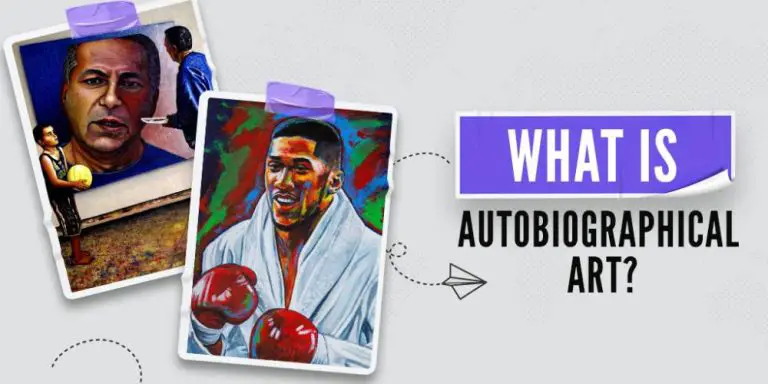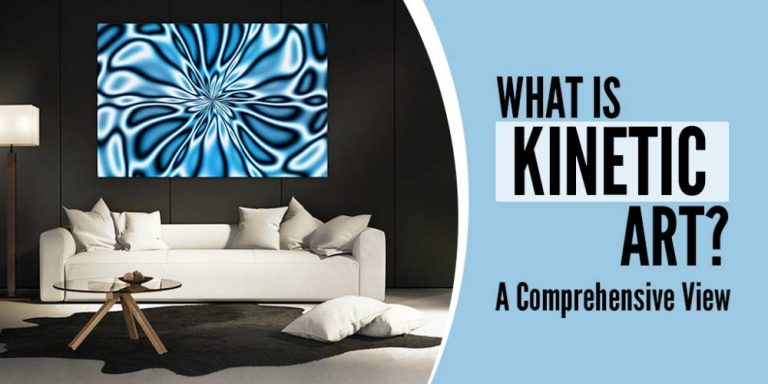The Beginner’s Guide To Conceptual Art: What’s The Big Deal?
Conceptual art can be an ambiguous art form and difficult to understand, especially if you are new to the art world. But it does have its appeal. Conceptual art is important in the evolution of contemporary art.
Conceptual art is an art form that is all about the idea itself. In conceptualism, there is more importance placed on the planning and decisions that go into the work, than on the end result. This means that an artist does not need to have any traditional skill or artistic ability to produce conceptual art.
Keep reading, as we have developed a comprehensive conceptual art guide for beginners and experts alike. Stay with us to learn what conceptual art is, some art history, and how to appreciate conceptual art.

(This article may contain affiliate links and I may earn a commission if you make a purchase)
What Is Conceptual Art?
As a beginner’s guide, we will ease into what conceptual art is and give you an overview of why the conceptual artwork style is such a big deal. Conceptual art places a larger importance on the idea behind the artwork rather than the finished piece of art itself. This type of art was first defined by Sol LeWitt in 1967. He is even more specific in his groundbreaking essay, where he states that conceptual art makes “the idea itself…a work of art.”
The following is a list of types of art that can fall under the umbrella term conceptual art:
- Architectural drawings
- Body art
- Documents
- Drawings
- Earth and land art
- Happenings
- Installation
- Movement
- Music
- Performance art
- Photography
- Sculpture
It is important to note that the medium used is not of major importance in conceptual art. A physical form is not even necessary to be considered conceptual art.
With conceptual art, any medium can be used to express an artist’s vision. Oftentimes, the artist’s goal is to challenge a viewer to notice different characteristics about a piece of visual art or to create a piece of art around a controversial topic.
The following are key characteristics of conceptual art:
- Humor – It is common to see many conceptual artists poke fun at a specific idea and use humor to convey their vision.
- Space – Artists look to draw a viewer’s attention to the space surrounding a piece or to a particular space that contains a piece of art.
- Thought – Conceptual artists are known to create thought-provoking pieces. Their art may make you question their idea, the piece itself, how it reflects in society, and much more.
- Time – Many artists also look to explore how time can change an idea, space, person, etc.
In essence, conceptual art was developed to push back against the rigid standards of traditional, contemporary art. As a medium, conceptual art doesn’t necessarily need to display all of the characteristics above. It is also still considered conceptual art, even if none of the above characteristics are seen within the piece of art.
Why Is Conceptual Art Important?
As you are probably undoubtedly wondering by now, why is conceptual art so significant? The answer to your question is quite simple. Because conceptual art challenged the current definition of what it means to be art, it expanded the eyes of artists, institutions, and society. Because of this, it created a significant shift in the art world.
Conceptual art, as thought-provoking as it was, paved a new path for artists and their audience. Art interpretation became more ambiguous and tended to dematerialize art to get to the root or essence of the concept, idea, object, or installation in view.
The Roots Of Conceptual Art Are In Minimalism
Conceptual art is based on quite a few previous art movements, including minimalism. The main importance of minimalism is conceptual art’s rejection of needing a conventional medium to produce museum-worthy art installations.
However, it uses minimalism’s key concept of reducing the overall presence of a piece of art to a minimum. Sometimes the art becomes so minimal, it is only the idea and never becomes a tangible form.
One of the reasons why conceptual art is such a big deal is because it strays so far from the traditional understanding of art. To be considered conceptual art, you can create anything and call it art.
And all art is, in essence, conceptual because all art is based on an idea. However, conceptual artists take it one step further and go on to say the idea itself is the art.
A Brief Overview of Conceptual Art
Now that you have an idea of what conceptual art is and why it is such a big deal let us cover some of the key points in the history surrounding the origination of conceptual art as a full-blown movement.
Below we discuss the key points in the conceptual art movement, including:
- The evolution of conceptual art to today’s time
- The history of conceptual art
- The original inspiration for conceptual art
- The subcategories of conceptual art
Art is subjective, making defining conceptual art that much harder because conceptual art is based on ideas and concepts. However, it does have a detailed history that helps to shape our understanding of conceptual art as it is seen today.
The History of Conceptual Art
Conceptual art began in the early 1900s but did not develop into an artistic style and movement until a little over halfway through the 20th Century. We cover the history of conceptual art as it provides a detailed insight into the original thought behind the art style and movement.
In the following table, we have summarized some of the important markers of the conceptual art movement:
| Important dates | Locations of Interest | Key Phrases |
|---|---|---|
| – The breadth of the movement occurred between the mid-1960s and mid-1970s – The earliest conceptual art was seen in the 1910s – The latest conceptual art is seen through the 2010s | – Asia – Europe – Germany – Japan – Latin America – Mexico – Russia – United States | – Art & Language Group – Concept – Idea – Language – Minimalist – Modernism – Political – Postmodern – Transitional |
The above chart provides a short overview and consolidates important information in the conceptual art movement. As you can see, the conceptual art movement was widespread around the world and throughout history.
The following is a short timeline of the rise of conceptual art as a predominant art style and movement:
- 1917 – The earliest known account of conceptual art is exhibited by Marcel Duchamp as Fountain.

- The late 1950s – One of the key pieces of art was Black Paintings by Frank Stella. The creation of these works marked the end of Modernism.
- 1961 – Henry Flynt, best known in the Fluxus movement, referred to his performances as “concept art.” However, the term conceptual art was not coined until later.
- 1966 – Art & Language Group is formed in England by Terry Atkinson, Michael Baldwin, David Bainbridge, and Harold Hurrell.
- 1967 – As we mentioned previously, Sol LeWitt published a landmark essay on conceptualism titled, Paragraphs on Conceptual Art.
- 1967 – Titled (Art as Idea as Idea) by Joseph Kosuth is exhibited, and called for the examination of language as it is understood and used in the modern art world.
- 1967 – Arte Povera emerged as a conceptual artist focused on releasing the constraints placed on traditional artwork.
- 1968 – Influential word paintings by John Baldessari were exhibited in Los Angeles.
- 1968 – Daniel Buren is critiquing France’s institutions and the expectations around art as it is exhibited.
- 1969 – Cildo Meireles was using his conceptual art to make a political statement. Notably, he would use ready made objects and assign a political message only to recirculate the item in society.
- The 1970s – The Moscow Conceptualists emerged, combining Soviet Socialist Realism, American Pop, and Conceptualism into their art installations.
- 1973 – Six Years: the Dematerialization of the Art Object (Amazon), a book by Lucy Lippard, is published documenting and critiquing the conceptual art movement from 1966 to 1972. But her book was highly criticized for being confusing and an untrustworthy recount of events.
As you can see, the first instance of what is now referred to as conceptual art was seen in 1917. However, the movement did not fully take root until the 1960s and 1970s. Ever since the inception of the conceptual art movement, it has influenced the art styles and movements that developed after.
Conceptual Art Broken Down into Categories
Conceptual art developed into a few subcategories as it evolved into a burgeoning art form. As it ended up, there were three major categories to which you could assign most conceptual art of the 1960s and the 1970s.
There are also a few different subcategories you can use to define the aspect of conceptual art history more easily:
- Art as an idea – This is a piece of art or installation that is designed to question its own purpose continuously
- Art as language and words – This is a type of art that incorporates or solely features text in an artistic expression, whether in painting, digital art, or mixed media.
- Concepts as photographs – Since most conceptual art pieces were based on ideas and concepts, artists embraced the modality of performance to convey their vision. This meant that their performance was documented and captured using film, either video or photography.
Examples of these subcategories of conceptual art include the following:
- Every Building on the Sunset Strip – by Edward Ruscha. This work is an example of photo-conceptualism. Ruscha uses the simple setup of mounting a camera to his truck to collect images and document a point in time.
- Living Series – by Jenny Holzer. This is most clearly an example of art as language. In this installation, Holzer uses bronze plaques that have short phrases describing the necessities in life.
- Statements – by Lawrence Weiner. His text work is an example of art as an idea, whereby he explained in short statements ideas and concepts.
As you may have gathered, however, conceptual art is not constrained to one single subcategory, or even the three we discussed, for that matter. Conceptual art is so vaguely defined that almost anything you want to call art can be art. And we discuss how this can make appreciating conceptual art difficult later.
The Inspiration and Evolution of Conceptual Art
As we have mentioned, conceptual art was first seen in the early 1900s, but it was not a part of an artist’s lexicon until the late 1960s. There are quite a few movements before conceptual art that influenced its development into an artistic style and movement.
The following is a list of movements and styles that inspired conceptual art:
- Fluxus
- Minimalism
- Abstract expressionism
- Neo-Dada
- Pop Art
- Surrealism
While some of these movements co-occurred with the conceptual art movement, they all started before conceptual art was defined and developed into its own form of expression.
Additionally, conceptual art sparked a distinct change in how art was viewed and what it meant to be an artist. It led to the creation and evolution of many other art styles and movements.
The following is a list of movements and styles that many ideas from the conceptual art movement inspired and further evolved into:
- Feminist Art
- Found Object Art
- Identity Politics
- Installation Art
- Institutional Critique
- Pictures Generation
- Social Issue Art
Some later conceptual artworks incorporate these inspired movements into their pieces. Key examples of this include the following works of art:
- Lustmord – by Jenny Holzer. This piece incorporates identity politics, social issues, and feminism into her conceptual art piece.
- MoMA Poll – by Hans Haacke. This interactive installation combines conceptualism, institutional critique, social issue art, and installation art.
- Thou Shalt Not Commit Adultery, plate VII from the portfolio The Ten Commandments – by Vito Acconci. This work crosses into institutional critique, social issue art, and perhaps even some influence from the Pictures Generation.
Famous Pieces of Conceptual Art
There are quite a few famous pieces of conceptual artwork, as we covered briefly in the history of conceptual art. From the 1950s through the 1980s, conceptual art was a burgeoning movement. And so we have compiled some of the most groundbreaking visual installations from this era of conceptual art.
The following chart highlights eleven important works of art, also noted is the creator and the year it was exhibited:
| Name of the Piece | Artist | Year | Short Description |
|---|---|---|---|
| Erased de Kooning Drawing | Robert Rauschenberg | 1953 | Using an estimated 15 erasers, Robert Rauschenberg erased an artwork from another prominent artist of the time, Willem de Kooning, leaving behind just the “idea” to be framed. |
| Grapefruit (Amazon) | Yoko Ono | 1964 | Drawing on both the conceptual art and Fluxus movements, the book shares instructions on how to create various forms of art. |
| One and Three Chairs | Joseph Kosuth | 1965 | Shows the physical chair, an image of the chair, and a definition of the word “chair.” |
| Every Building on the Sunset Strip | Ed Ruscha | 1966 | Ruscha used a truck with a camera attached to capture images as he drove back and forth down the strip. This art draws again on the concept over the technique used. |
| A Line Made by Walking | Richard Long | 1967 | As a break into Land art as well as conceptualism, Long walked back and forth on a strip of grass in a field to flatten a path and create a sunlit line visible to the naked eye. He recorded his action using photography. |
| MoMA Poll | Hans Haacke | 1970 | One of the earlier politically motivated installations of conceptual art, this piece asked museum-goers to cast their ballots, based upon a question about the then governor, who was a prominent MoMA donor, demonstrating that art is a collective effort. |
| Active Poetry | Ewa Partum | 1971 | Partum used deconstructed language to create poems that were scattered during performances in outdoor locales. |
| I like America and America likes me (see video above) | Joseph Beuys | 1974 | Defining his anti-Vietnam war stance, Beuys spent three days in a room with a coyote while he was wrapped in felt. It turned out to be one of his most famous pieces of performance art. |
| Post-Partum Document | Mary Kelly | 1975 | Using ideas in psychoanalysis and feminist theory, Kelly documented a six-year period after her son’s birth in various media. In Documentation III: Analysed Markings And Diary Perspective Schema (Experimentum Mentis III: Weaning from the Dyad), there are 13 panels of collages of written and typed words with some diagrams. |
| Vertical Earth Kilometer | Walter de Maria | 1977 | Creating a piece of art that forces the imagination to flex, de Maria drilled a hole in the ground, inserted a rod, and covered it with a plate that revealed only a piece of the rod as it comes to the surface. |
| Imponderabilia (see video below) | Marina Abramovic | 1977 | A performance-based art installation whereby Abramovic and her partner face each other naked in the museum doorway. The idea was to have visitors squeeze between their bodies and explore the reaction it incited. |
Now that we have examined some of the famous works of art to emerge from the conceptual art movement let us dive into the contributions from the most influential artists in the conceptual art style.
Famous Artists Known for Their Conceptual Art
Throughout the conceptual art movement, there have been quite a few famous artists. Below we discuss some of the key conceptual artists. If you get the chance, you should explore their work in-depth because each artist takes a different approach to the conceptual art movement.
The following is a table that shows the information of famous conceptual artists and their most significant contributions to the conceptual art movement:
| Name of Conceptual Artist | Significant Contributions to Conceptual Art Movement |
|---|---|
| Damien Hirst | – British artist – Plays on the ideas of life and death in his work – Sculptor and painter – The Physical Impossibility of Death in the Mind of Someone Living (1991) – Used rotting corpses often in his work |
| Jenny Holzer | – American artist – LED signs were her standout pieces – Throughout her career, she showcased a wide range of art that adapted to almost every audience – Used mixed media for her conceptual art, such as text, sound, video, and light – Uses social injustice, political protest, and the human psyche as fuel for her artistic ideas and declarations |
| John Baldessari | – American artist – Calls on contemporary art theory, the juxtaposition of imagery, and painting to deliver his message – Heavily impacted the pop and conceptual art era in the 1980s – Known for his influential teaching approach – Uses both image and language as the focus of his pieces |
| Joseph Beuys | – Created distorted realities and challenged the idea of normalcy – Dabbled in many different media, including installations, painting, sculpture, and performance art – German artist – Highlighted the duality of art representing both personal and universal ideals – Used humanism, philosophy, and political ideas as staples in his art |
| Joseph Kosuth | – American artist and essayist – Incorporates literature, philosophy, psychology, and history into his pieces – One and Three Chairs is one of his famous pieces – Provoked an analysis of experiencing, understanding, and interacting with language – Used ideas, images, and words to influence his work |
| Robert Rauschenberg | – American artist – Questioned the definition of “art” and “artist” – Used texture and emotion in his art installations – Used various media, including sculpture, collage, painting, and digital methods |
| Robert Smithson | – Also drew on ideas from science, including entropy, thermodynamics, and geology, to influence his work – Also known as a painter, collagist, and writer – American artist – Famous for expanding the Land and Earth Art styles – His later work used sculpture as the heart of his artworks – Influential in defining the concepts of site and non-site – Spiral Jetty is claimed to be his most famous work |
| Sol LeWitt | – American artist – Famous in conceptual art and the minimalism movement – Focused on concepts and systems as a subject for his art – Sculpture, painting, and drawing were all media he used – Used geometric forms and symbols |
| Walter de Maria | – American artist – Focused on sculpting, composing, and multi-media forms of art – Influential among composers, musicians, and performers – Many of his works fell under the Earth and Land art movement – Most famous for The Lightning Field (1977) |
While this does not cover all conceptual artists, these were the most prominent artists as conceptual art rose in popularity. So, we have covered what conceptual art is, why it is important, and who and what is behind the more substantial pieces of conceptual art. Do you have a favorite emerging?
How Do You Appreciate & Understand Conceptual Art?
The idea of appreciating conceptual art is utterly absurd to many individuals. It can be difficult to take conceptual art seriously when compared to more traditional and technical forms of art. However, that is the beauty of conceptual art. It draws on the audience to interact, think about and decipher the true meaning of a piece of art.
The Controversy of Conceptual Art
That all being said, it might still be quite difficult for you to be able to appreciate and understand conceptual art. So, we are here to break it down for you and give you some tips on interpreting conceptual artwork.
Many people feel a range of feelings and emotions when they encounter a conceptual art installation:
- Admiration
- Anger
- Confusion
- Contempt
- Joy
- Laughter
The is because conceptual art is so foreign to us. We have been trained to accept traditional art as the standard. So, when we see conceptual art, and it falls outside of the categories we conventionally assign to art, not only is it confusing, but it can be enraging.
This anger stems from many classically trained artists who have been resistant to “lowering the standards” of what is considered art. Because conceptual art, as it is defined, means anyone can create something and call it “art.”
Defining Conceptual Art for Yourself
When you are trying to understand and appreciate a piece of conceptual art, you must search for yourself what the piece you are viewing makes you think, feel, and experience. Ultimately, you can read about many of the pieces of conceptual art to figure out what the artist’s original motivations for creation were.
But with conceptual art, it is even more impactful for the piece to take on its own larger meaning based upon the audience’s reaction.
Following are a couple of questions to ask yourself when considering conceptual art:
- Is it meant to be taken literally? – Oftentimes, conceptual art is presented in one form, but it is poking fun at a deeper subject matter. Or is the urinal just supposed to be a urinal?
- How much does it push the boundaries of traditional art? – Conceptual art is quite often designed with the idea in mind and not the final result, so the piece you end up viewing may deviate drastically from the more traditional forms of art.
After asking yourself the above questions, you should also define conceptual art for yourself. Ultimately, conceptual art is intended to become part of the conversation, and it is meant to provoke strong feelings and emotions in the eye of the beholder.
In Summary: Conceptual Art Is A Big Deal
Conceptual art is rooted in disrupting the narrative that art has to look a certain way and be created a certain way. The development of this movement gathered influence and inspiration from minimalism and rejected formalism.
Conceptual art had a strong representation among famous artists that spanned decades. From 1917 through today, conceptual art is a big deal. Ever since it was first defined in 1967, conceptual art has been challenging the conventional notions of art and expression.








